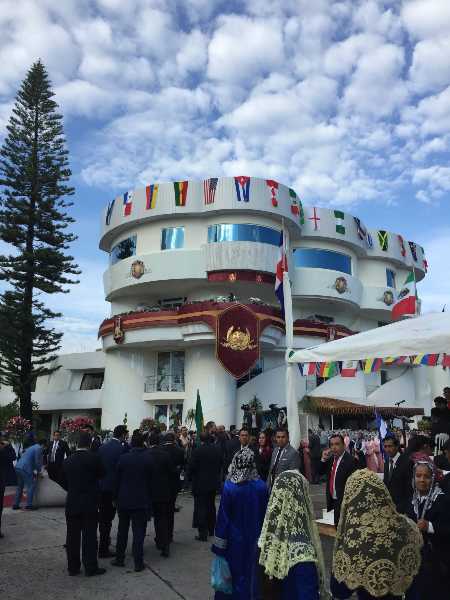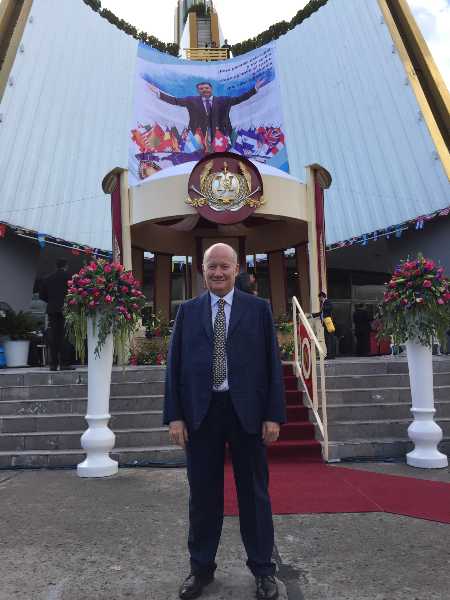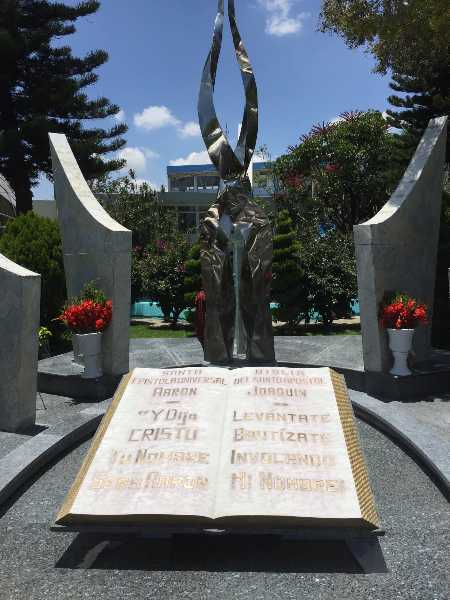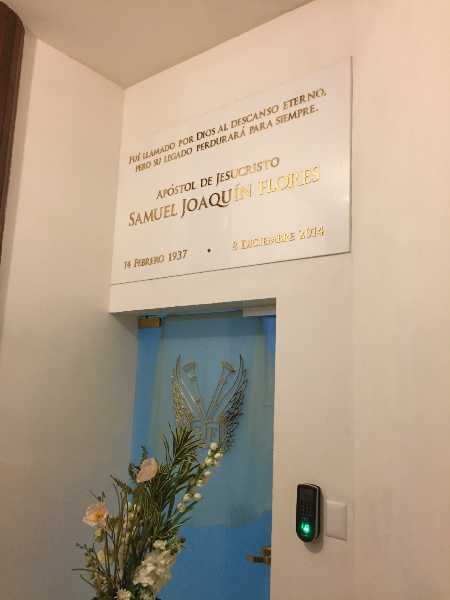CESNUR - Centro Studi sulle Nuove Religioni diretto da Massimo Introvigne
www.cesnur.org
www.cesnur.org
The world’s fastest growing religion” is now a cliché. Mormons used the slogan for decades, until their growth slowed down. Islam’s claim to the title is as good as any other religion’s. As a frequent visitor to East Asia, I believe that China’s Church of Almighty God and Korea’s Daesoon Jinrihoe are part of an elite club of religious groups growing very fast. Statistics are a matter of contention, and scholars can only offer educated guesses. Outside of East Asia, La Luz del Mundo, whose headquarters are in Guadalajara, Mexico, may well be the fastest growing movement. It is also not impossible that it actually grows faster than the Asian groups I mentioned, thus deserving the title of the world’s fastest-growing religious movement. That these groups are less studied than others by international scholars of new religious movements depend on linguistic reasons (the best part of their materials is published in languages other than English), but also tells us that we should learn to look beyond Europe or the United States.
Since 1931, the main religious act of La Luz del Mundo has been its yearly celebration of the Holy Supper (Santa Cena). On August 9, 2018, I went to Guadalajara for the welcome ceremonies leading to the event. Unfortunately, I could not stay for the whole week and the Holy Supper proper, as I was scheduled to speak at the Association for Sociology of Religion’s yearly conference in Philadelphia, but the welcome ceremonies offered more than a taste of the event.
It was not my first visit to the Beautiful Province (Hermosa Provincia), the main center of La Luz Del Mundo in Guadalajara, Mexico. As a veteran of the so called “cult wars,” I got interested in La Luz del Mundo in 1997, when it was attacked as a “cult,” with the leaders accused of being involved in child abuse and possibly preparing a mass suicide. The accusations immediately looked as the usual anti-cult stereotypes, and the character mostly responsible for spreading them, Jorge Erdely, was the pastor of a much smaller rival religious movement, the Restored Christian Church, who was later accused himself of operating an authoritarian “cult-like” organization and other wrongdoings. However, the accusations made the international anti-cult circuit, and investigating La Luz del Mundo was worth a trip to Guadalajara in 1998.
Back then, I did not really plan to study the church. I wanted to meet Mexican colleagues, including Renée de la Torre Castellanos (whom I met again in 2018), who assured me that the anti-cult agitation was indeed what it looked to be, and have a taste of La Luz del Mundo by visiting the Hermosa Provincia (who, at that time, had a picturesque zoo with real lions: now, only some parrots are left) and attending a morning service. I concluded that they were peaceful Christians unjustly accused because of personal vendettas, and in the following years followed the development of their activities in Italy and elsewhere.
In the meantime, the scholarly production on La Luz del Mundo in languages other than Spanish did not substantially grow. The best introduction is the entry Mexican scholar Patricia Fortuny wrote for the World Religion and Spirituality Project in 2016. For those reading Spanish, Renée de la Torre’s studies are still worth reading, although as usual scholarly studies cannot replace the direct contact with primary sources.
In short, La Luz del Mundo was founded by Eusebio Joaquín Gonzalez (1896–1964), who, according to his own account, was renamed Aarón by God and told to restore the original Christian Church in 1926. Gonzalez was a military man, and 1926 was the year when the Cristero Catholic rebellion against the secular and anticlerical Mexican government of Plutarco Elías Calles (1877–1945) started. As was true for many in the Army, Gonzalez was critical of the Catholic Church and its power in Mexico. He joined a group called Christian Spiritual Church, and eventually left the army. He and his wife served full time the two leaders of the Christian Spiritual Church, until they became disillusioned with their antics, and Gonzalez heard the call from the Lord to establish his own Church, or rather to restore the Church as it had existed in the first centuries.
Original sources I consulted in Guadalajara show that, contrary to a certain rhetoric in the Catholic accounts of the Cristero War, the Army, while fighting the Catholic rebels, did not necessarily promote or protect the Protestants. Actually, some military commanders believed that Protestant activities provoked the Catholic population and played in the hands of the Cristeros, and actually suppressed them. Groups like Gonzalez’s, thus, found themselves in the uncomfortable position to be assaulted by both the Cristeros and those fighting them. There is little doubt, however, that present-day La Luz del Mundo regards itself as the heir of those who opposed the Cristeros. Its library collects forgotten anti-Cristero novels, and pamphlets against the lionizing of the Cristeros, including through the beatification of some of them, by present-day Catholic Church are still published.
The Cristero War ended in 1929, but not the difficulties faced by Aarón. He managed, however, to celebrate the first Holy Supper in 1931 in Guadalajara, where he built his first place of worship in 1934 under the name La Luz del Mundo. The growth was sustained both in Guadalajara and around Mexico and soon the movement experienced the fate of all growing churches, schism, with the separation in 1942 of the Good Shepherd (Buen Pastor) group, which still exists with some 17,000 members in Mexico. This did not stop the growth of Aarón’s group, which in 1952 purchased land to establish a neighborhood in Guadalajara inhabited almost exclusively by members of the Church, the Hermosa Provincia. By the time of Aarón’s death in 1964, the Church had expanded to Central America and the United States, and counted some 25,000 members.
The Church explains that succession in the role of Apostle is by divine call, validated by the community, to which the choice clearly appears as the will of the Lord. It is true that Aaròn was succeeded by his son Samuel Joaquín (1937–2014), and the latter by his own son Naasón Joaquín (b. 1969), but neither was the eldest son of his father.
Samuel Joaquín presided over a phenomenal international expansion, traveling incessantly throughout the world and building new temples. By 1993, the Church had reached the mark of four million. He also greatly expanded the Church’s impressive network of charitable activities, which serves both members and non-members of La Luz del Mundo. In the last years of his life, health prevented Samuel Joaquín from traveling, but international missionary activities were boasted by the succession of his fifth son Naasón Joaquín, who succeeded his father in 2014.
La Luz del Mundo, because of its history and theology, faces obvious opposition from the Catholic majority in Mexico. Since they baptize in the name of Jesus Christ only, and claim to have restored the primitive Christian Church through the authority the Lord conferred to the apostles Aarón, Samuel and Naasón, they are also regarded as unorthodox by Evangelical counter-cult activists. Secular anti-cultists and feminists oppose the lifestyle of the group’s women, who wear long skirts and live according to conservative family values. However, I met long-skirted women with professional skills and credentials as journalists and historians, the latter engaged in the much-needed endeavor to preserve and classify early documents of the Church. I was not surprised, as I had met equally skilled journalists, lawyers, and academics who are veiled Islamic, or conservatively dressed Christian or Orthodox Jewish women.
In 2018, I met Nicolas Menchaca and Bigvai Estrada, two pastors of La Luz del Mundo, at a conference at University of Southern California in Los Angeles. We renewed the acquaintance, and this led to Bigvai Estrada attending an event on religious liberty I organized at the United Nations in Geneva, to visits, alone or with other scholars, to Luz del Mundo temples in Houston, Washington DC, and New Jersey (all largely built, like the ones in Mexico, through the members’ own volunteer work), to the participation of the Milan choir of the movement to the Faith in Tunes religious music festival I co-organized in Turin, Italy, and finally to my second visit to Guadalajara.
The city had changed since 1998, and so had La Luz del Mundo. Some 500,000 devotees from 57 countries attended the welcome ceremony. They would have been more, had the Church not decided that from 2018 on the United States would have their own yearly ceremony, and American members would no longer travel to the Guadalajara event. Indeed, a parallel celebration in February in California gathered more than 150,000 Luz del Mundo members from the U.S.
The atmosphere was festive and not only the Hermosa Provincia, and the other barrios were the Luz del Mundo brothers and sisters live, had been taken over by devotees from all over the world. The whole city of Guadalajara participated in the celebration, and leaders and foreign guests were received at the City Hall by the major. Clearly, after the initial problems and the anti-cult controversies of the late 1990s, the city is now proud to be the center of a world religion that claims seven million members from so many different countries of the world. I was moved by the accounts of the trials and successes of members in Russia, and by the experience of the (so far) lonely Polish member.
All the foreign delegations marched in the welcome ceremony I attended, while thousands sang “Welcome.” Politicians and academics sat in the tribune, including members of the Parliament and other authorities. The diverse group confirmed what Mexican scholars have noticed. While decades ago the local media took for granted a relationship between La Luz del Mundo and the Institutional Revolutionary Party (PRI), the secularist party claiming the heritage of the Mexican Revolution, today all sort of politicians are friendly with the Church. Smiling in the tribune, among senators and academics, was Margarita Zavala de Calderón, a Catholic politician and a former First Lady of Mexico, who founded her own party and was a (defeated) candidate in the recent presidential elections.
The arrival of Apostle Naasón was awaited and greeted with great enthusiasm. He spoke forcefully inside the great temple of the Hermosa Provincia, and I had the opportunity of meeting him in his Apostolic Home and exchange a few words after a meal he offered to foreign guests. He is a charismatic speaker and an articulate, pleasant, and intelligent man, interested in how academics see his Church. The question Patricia Fortuny asked whether Naasón would manage to be as charismatic as his father and grandfather should, I believe, be answered in the affirmative.
I also toured the impressive facilities of the Church in Guadalajara, including the state-of-the-art TV, radio and Internet network Berea International, the historical archives, and the library. The short stay in Mexico prevented an in-depth visit to the charitable institutions, which would surely have been worth the while.
I went back from Mexico still puzzled by the problem of statistics, which does not concern La Luz del Mundo only, but persuaded that the figure of seven million members should not be too much off mark. Not only the crowd was impressive, but success stories shared from both Church members, and political and academic guests, from countries such as El Salvador and Costa Rica mentioned thousands of churches in these small countries. I also learned about the system of “battalions,” groups trained to hit a specific city or country where the Church is not yet present. I told the Apostle and his co-workers that I see a great potential for expansion in the Far East, where the Church has not really started its missionary activities yet.
In all continents, missionaries are at work, figures are growing, and the Luz del Mundo Church never sleeps. More sleepy have been foreign scholars, who have not devoted to this Church the attention it deserves. This could and should be taken care of in the future. The future of the international academic study of La Luz del Mundo would, as is true for other groups, also depend from the attitude of the Church itself. And it would also prevent distortions and falsehoods, still occasionally spread by anti-cultists who have not forgotten the controversies of twenty years ago.
Photo Gallery



